No, I’m not a collector, but I did spend $407.44 on a crosscut saw that was given to me (for free). Let me explain, because I’ve got a really nice Husqvarna chainsaw from my woodturning days so what in the world do I need a crosscut saw for?
As we contemplate what sustainability really means on our farm, I’ve been exploring the world of antique hand tools which has been a hobby of mine for years anyway. I’ve got hand planes and hand drills, braces and bits that I have used to build a little furniture for my wife and now, I’m gradually expanding into a few tools that I use around the farm.
Here’s a few of the tools I’ve collected over the years, in a tool chest I built to house them.
I’ve been working on a cherry tree carving spreaders (did you see that post?) and I’ve used a little hand saw for cutting up the limbs. Here’s a picture of the tree.
It died last winter and needed to come down, so I’ve been knocking two birds out with one stone as they say, converting a dead tree into useful spreaders. But as I approached the larger trunk of the tree I had two options:
This is conflicting to me, philosophically. The chainsaw was expensive, but it’s been paid for years ago and will last many years to come with a little care. And the chainsaw is fast, extremely fast. I could have cut up that cherry tree in a half hour. The chainsaw is versatile too; it can cut the smallest of limbs as well as the biggest of stumps. And I’ve been using a chainsaw for fifteen years, so I know how to use one, I know how to sharpen one, etc. But it runs on petroleum which quite simply isn’t sustainable. I can’t produce gasoline and mix oil myself and the world manages to stay in a state of warfare over it so, I thought it would be nice to use a crosscut saw.
That hand saw? An older gentleman I used to work for gave it too me; it was his father’s so, it’s over 100 years old. The saw was covered in rust, the handle had a few cracks, and it was missing the helper handle. I spent 3-4 hours sanding rust and restoring the handle and brass nuts. Then came the expensive part. Have you seen helper handles and sharpening equipment for this kind of saw at the hardware store down the street? Well, the hardware stores are gone, so now it’s Lowes and Home Depot and I don’t think they ever carried hand saw maintenance tools. So I turned to the Internet and found the Crosscut Saw Company out of Seneca Falls, NY. Come to find out, there are still a few guys that use these saws clearing trails in the National Parks and the like out West. So by the time I bought the helper handles, the manual on sharpening, the saw files, the jigs for filing, the peening hammer and anvil, well, I’m over four hundred dollars into this thing.
Here’s a shot of some of the tools I needed to maintain this saw:
And my predicament with the cherry tree gets worse. I’ve restored the crosscut saw, but I haven’t learned how to sharpen it yet. It’s not rocket science, but it does take some learning to joint all the teeth to the same height, then to swage the rakers and actually sharpen the teeth. So that’s on the list, but I haven’t gotten to it. And I kind of know how to use it, but I have no real experience with it like I do my chainsaw.
If that wasn’t enough obstacles to cloud my decision, a one man crosscut saw works for stuff down to about 5″ in diameter, but it doesn’t cut small limbs very well. So now I needed an axe. I don’t remember what I paid for this axe, but add that to the list of how expensive it was to cut down a tree “sustainably.”
As I contemplated which tool to use to cut up that cherry tree, I figured, I’m making the spreaders by hand, but I don’t have time to stop and learn to sharpen this hand saw and then cut up the tree by hand. By then I’ll be sold out of spreaders and too far behind to catch up. So, decision made, I grabbed my big chainsaw. Thirty minutes and I’d be done, on to carving with my axe and knife. Then, the saw wouldn’t crank. It needs a carburetor rebuild, fuel line and filter, spark plug and a general clean-up…
Actually, it’s been giving me trouble for months because of the stupid ethanol gasoline our government is pumping my money into. Now I had to use the hand saw. But it’s dull. Really dull. So the sustainable but slower option became even slower, and all I could do was get enough cuts made with the hand saw so that I could cut up the big pieces with my band saw in the shop – which runs on an electric motor which isn’t really any more sustainable than petroleum, but my four hundred dollar hand saw was dull…
Do you see the predicament? I mean sure, who cares about the little bit of fuel a chainsaw eats up. My Ford farm truck has a 460 engine in it which drinks more gas than I care to think about, but going back to a mule-drawn wagon is beyond ridiculous in the suburbs of Atlanta. As a side note, the gentleman that gave me the crosscut saw also has a picture of the Marietta Square from the early 1900’s, and the Square is piled full of mule-drawn wagons loaded down with cotton! So, what do we do in a world gone mad for speed? I love my hand tools; I love learning how to sharpen, use and maintain them, but they are painfully slow in light of chainsaws, weed-eaters, tractors, trucks and the like. I don’t even mind that the hand tools are slow, or that they require sweat to operate, but eventually you run out of daylight to do enough work fast enough to pay the bills. And here’s the two sticking points:
It’s the taxes and burdensome laws that keep us from moving back completely to a sustainable way of life in this debt-laden country. Never-mind that no one wants to go back to doing everything by hand, but no one could afford to. We could spend our lives learning the skills we need to grow all our own food and build and make all the tools, furniture, etc. we need to live without a Chinese factory pumping out cheap goods for us. We could pull the plug on this unsustainable way of life with hard work and help from our Mighty God – but how can we do all of that and pay the exorbitant taxes the government demands (as Rush reminds us, at gunpoint!). If we have an economic crash tomorrow, like ’29, we’ll need to be self-sufficient overnight, but we won’t be able to for the absurd level of taxes we’re expected to pay. How’s that for a problem?
The other obstacle is the expense of sustainability. Crosscut saws are all but obsolete today. I mean, I like hand tools and even I was taken aback that I needed as much money to sharpen a hand saw as I did to buy a new, smaller chainsaw. I mean, how do you justify that? I can’t not own the chainsaw because I need to work on my farm at the speed that tractors, trucks and chainsaws allow me to work. But then to move towards sustainability I need to spend even more money on terribly slow hand tools?!
There’s no clear cut answer to this problem, of course. In light of high taxes and hard to find tools, do we give up on the idea of human-powered, local-community driven sustainability? I say, No! I might not change the world, but my goal is just to quietly do what I can on our farm with my Daddy and my little boy. I can’t get rid of my truck for that mule-drawn wagon today, but I saved my pennies and did manage to buy the tools to sharpen my crosscut saw. And maybe I’ll have some time to learn to sharpen it soon, and I’ll just use it when I can. Then, when that economic disaster hits, that saw may be mighty important for putting up a little firewood to keep my family warm this winter.
What are you doing about sustainability in your life?

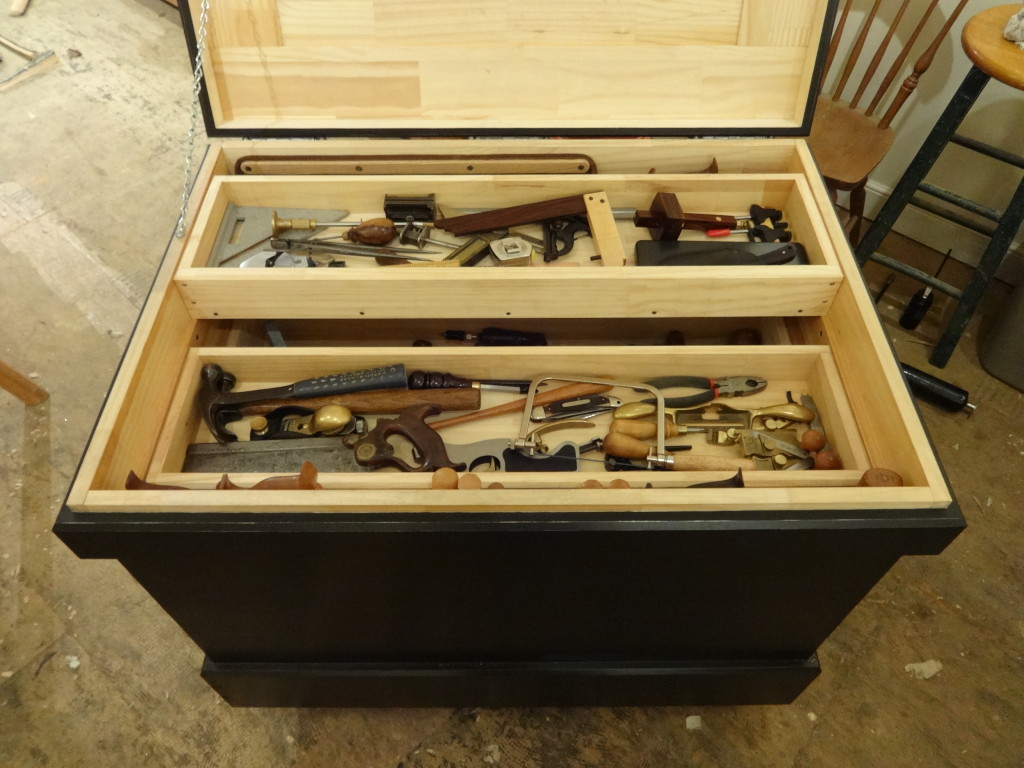

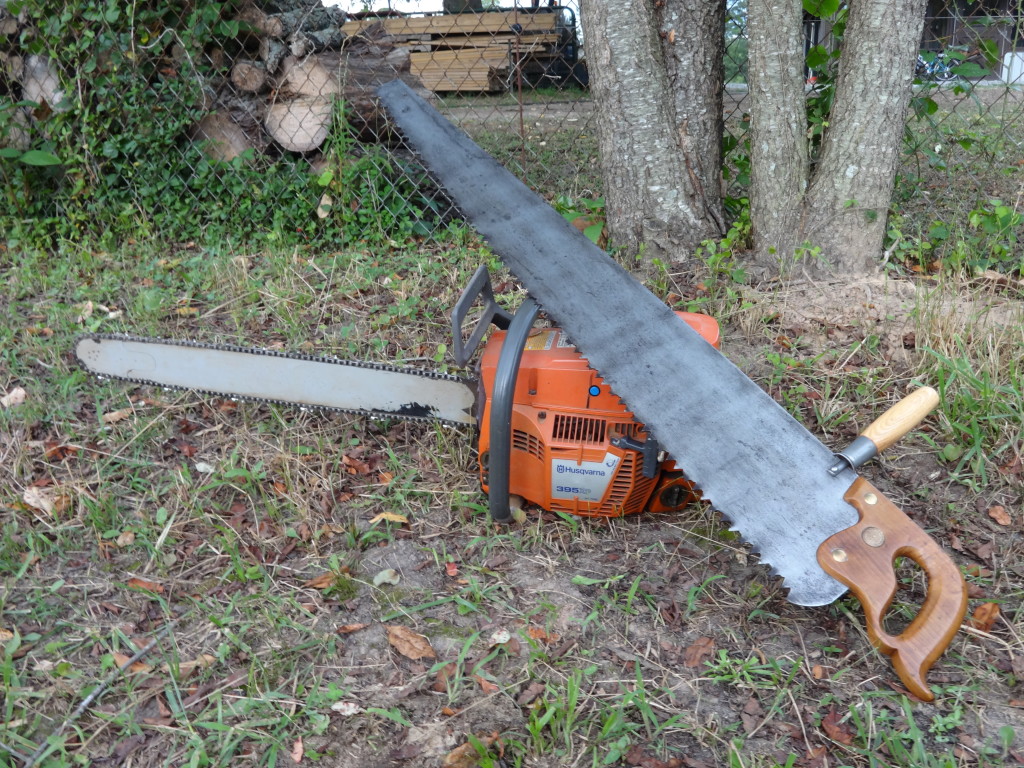

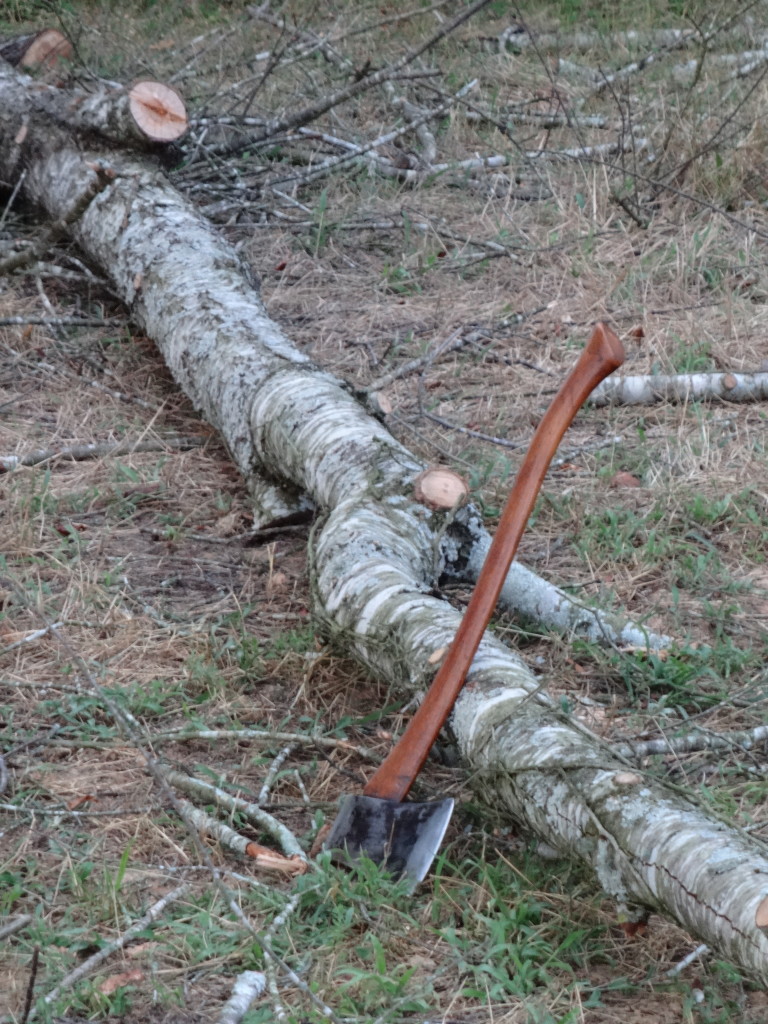
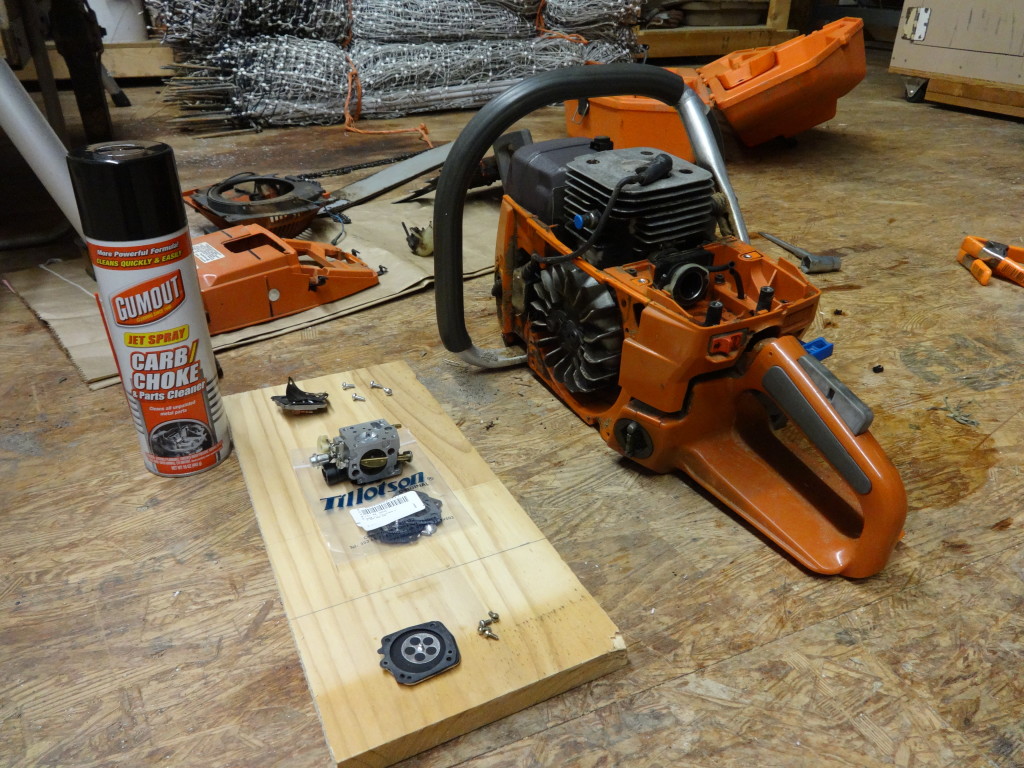
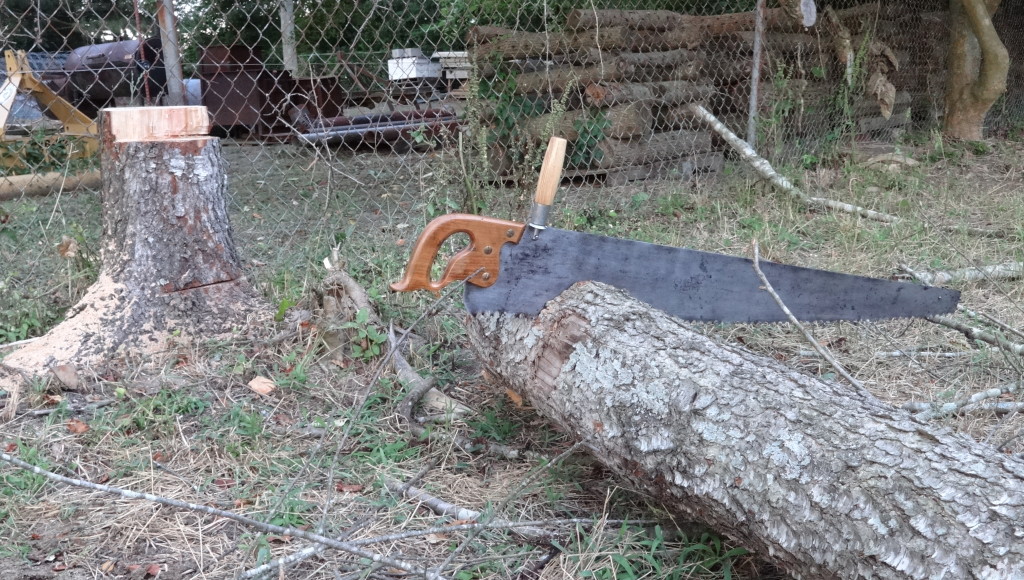
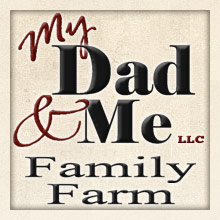
It is very difficult to disconnect from the “system”, isn’t it? I do enjoy the journey, even as a 50-something year old grandma! Hand-pulling weeds, hand-milking goats, hand-making soap….canning and dehydrating fruits and vegetables I’ve grown…it’s all part of my personal adventure toward a more sustainable life. I’ll never live long enough to learn it all, do it all, conquer it all. But, I’ll continue on this path as long as the Lord allows! There’s such a peacefulness to it all, and a powerful sense of being connected to Creation as we were meant to be. Thanks for sharing.
It is hard to disconnect Darlene, but indeed, what a journey! Life becomes very rich and full as we try, as Joel Salatin says, to re-make that visceral connection with the Creation, with the real, natural world. I guess the world just sees endless drudgery and work when they see cows, chickens and a garden, but the deeply fulfilling rewards of seeing the increase God provides for us through our hard work is hard to ever get over. Thanks for chiming in!
I can’t really say I’m further along the path you’re taking, but I will say I’ve been doing it longer. I was fortunate early in my “other” career to have men that guided me to older woodworking tools, hand tools. I was able to cobble together a collection that I use when I could, while using electric and gas tools also. I find now I use the tool that fits the time I have to make the project. I’m trying to make wooden spoons from tree trimmings, much like you. The limbs were cut by the tree trimmers. I used a band saw and table saw to square the limb, and a planer to make the rough stock. I will now use hand planes, chisels and knives to shape the wood. I won’t have access to the planer any longer, so I won’t use it and will hand plane the wood. I guess I use what I can, but still use older tools also.
I often think I’m more in touch with my grandparent’s age than my parent’s. I’d be curious what both of those generations would think of what we are doing. And I wish I had listened more intently when I was younger to their stories and lessons.
I do have to admit I get frustrated with machines that need work like your chainsaw. That’s why I don’t use mine as much as I used to. Keep the hand tools sharp and it’s keeps a job short and sweet.
The simplicity of a lot of the old hand tools is quite a draw to use them, Steve. We should all listen to the olden generations a lot more; once they’re gone they take with them an awful lot of knowledge that will have to be re-learned the hard way!
I have a question unrelated to your post, but I’m curious about your tool storage. Has the tool chest been easy to use? I’m trying to organize my tiny tool room/shop (8′ x 9′). I’ve seen chest and thought of building one, but want to keep the convenience of going to one place for wood tools, another for wrenches, a place for saws, etc.
What is your set up?
I’m working on a post right now about my tool chests (I have a large one that was in the picture, and a smaller one). I couldn’t be happier with the chests. They’re a great way to store your tools, very traditional, and I put mine on casters so if they need to move to the other end of my shop, bang, there they go. Do a little reading at the Lost Art Press blog and you’ll find a lot of good info about tool chests.
hahahaha i have to laugh with ya. i love the old tools and do enjoy working with them but when it is time to get something done, break out the power tools!!!! ethanol fuel is TERRIBLE for small carbs!!! dont use it. i learned this the hard way!! 2 weed eaters and 4 motorcycles and a leaf blower and lawn mower and my chain saw, all need expensive carb work! i rebuilt the motorcycles and the lawn mower. as soon as i can i will get the rest done.
Hey Big Bird! I wish our government would just get out of the business of stealing my money to do things that are just plain stupid! Ethanol got my wife’s little Mantis tiller too…
10% ethanol gas is indeed hard on small-engine fuel systems, mainly because it tends to undergo what’s termed “phase separation” fairly rapidly, with the ethanol and any water in the tank separating from the rest of the mix in as little as one month in storage. Oxidation and clogging soon follows.
I’ve found that the hot setup is to use the ethanol gas if I’ll be running the engine regularly, but when it’ll be unused for more than a couple of weeks to run the tank almost empty, then add a few ounces of TruFuel to the tank and run the engine for a couple of minutes. This way the entire system from tank to carb has non-ethanol fuel in it and can sit for a long time, over the winter if need be, and the engine will usually start on the first or second pull.
Regarding ethanol fuel – it might be worthwhile seeking out an ethanol-free gas station in your area. We have a few within an hour from me in PA, and it’s a little more expensive, but I believe the cost is worth it from a maintenance perspective. Apparently http://pure-gas.org/ has a nice listing. The various flavors of TruFuel and other shelf-stable fuels are pretty decent too, but get expensive very fast for someone who uses their 2-stroke equipment often.
My steps towards sustainability so far have included buying more hand splitting tools rather than investing in a log splitter for our wood heating needs. I suspect my opinion on this will eventually change, but I am determined to split most of my wood by hand while I am still reasonably able.
I’ve also been on an old woodworking hand-tool buying kick, and plan to continue picking up pieces as I find them at reasonable prices. I’ve grown interested in finer woodworking and am also learning to use these old tools at the same time. I may not use them all the time, but I would like to at least be comfortable enough to make some small pieces of furniture with them.
My wife and I have also been seeking out old garden tools rather than new ones, as I am certain most are made as well or better than new, and can often be found as bargains.
Outside of that, I just wanted to comment that I have been really enjoying this blog. I only started following it a few weeks ago after stumbling on a link from the Lost Art Press. Keep up the great work!
Hey Clayton, good to hear from you! I have found an ethanol-free station just a short time ago, and that’s all I’m using now. I’ll gladly pay a premium not just to avoid the carb work on my equipment, but also to cast my vote against using subsidized agriculture to fill my gas tanks!
Good for you on splitting wood by hand! Not only do you save the fuel but you get a lot of valuable exercise and skill from that kind of work.
There’s nothing like the old tools. I’ve been buying and restoring them on the side for almost 15 years and you have to buy from some of the few premium tool makers to find anything better today (like Lie-Nielson, Bad Axe, etc.).
Have you tried a wheeled hoe in your garden? I’ve got a new version, but it’s a great old tool for dealing with weed in the rows of your garden.
Thanks for reading and for your comments!
I’ve been in and out of the food related business for 25 years. Vendor, manager, cook, meatcutter etc. I’ve always shook my head “yes” to sustainability but have never been comfortable with what it actually meant. I have a notion of what it is. I worked in a meat department where ALL the meat was cut on the bandsaw= not sustainable. Taking the seeds from the tomatoes I’m growing and saving them for next spring= sustainable. So I looked forward to reading your post. My son, who works as a cook at two different chain restaurants walked into the room. He wants to further his carreer by going to culinary school. I asked him has he heard the word sustainable in either of the two kitchens. Unsuprisingly he said no. I told him to listen as I read the post because he will more than likely here it at some point in school. Thanks for the education.
I think sustainably is a really simple thing, but we live lives that are so un-sustainable we have a hard time grasping what the word really means. I think you’re pegging it with your tomato example though. If we can’t reproduce the energy source (fuel – as in propane and gasoline aren’t sustainable and draft animal power, firewood and human power are), or if we can’t reproduce the tool we’re using then it’s not sustainable. I would expand the definition just slightly beyond our individual self too: God never meant for us to be islands, so we need a local community to trade with. What we do not need is an unfair global economy where our tax money is doled out to places we don’t want it! Thanks for the comment Michael.
Pingback: Sustainable Farming. Myth or Partial Truth? | eastwestfarm
All you really needed for that saw was a combination jointer, not all that CC Saw Co. stuff. Such jointers can be had on Ebay for about 25.00 and are much better quality than the cast bronze implements you purchased.
Wish I had known that Dan! But I’ll give it a go with what I’ve got when I get a chance. Do you use a crosscut saw much?
Second on what Dan said. I’ve been a crosscut saw filer for a long time and can attest that the old tools are the best tools. Besides, there are not that many competent filers out there and the jointers/gauges can be had for so much less on Ebay than retail. You bought the whole package from CC Co., but the long Gibbs-style jointer is overkill for your short saw.
If you’re really curious about this craft, visit crosscutsawyer.com for a discussion of the techniques.
Thanks for the info! Wish I had known. I don’t know anyone locally that actually uses crosscut saws, so I was in the dark about what to buy. But I’ll check out the link. Thanks!
Pingback: A Real Man’s Miter-box |
Regardless of if it was a good deal or not, those sharpening tools will last you not only your lifetime but your childrens as well, for generations, and you can lend them to friends and neighbors who can’t save for them, a community only needs one saw jointer really. In our individualistic time we forget the power of our neighbors and the tools they have at their disposal. That kind of thing is what makes those technologies sustainable. Some old hand tools my dad and grandfather bought I still use every day, and my children will as well, even if they cost a thousand bucks it’s still one hell of a deal over time vs anything that has constant financial inputs! Over a hundred years any costs really add up.
That said if you want to recoup some of your loss, I’ll gladly buy that long jointer off of you, I have some long two man saws that my short jointer won’t work on.
I agree Will, we are so short sighted today! The jointer and saw are taking a back seat right now as we start farming here in Alabama, but I hope to get back to my hand tools soon; maybe this winter will afford some time to work some wood by hand; I miss it!
I thoroughly enjoyed your post and agree with many of your thoughts/concerns. We moved out to the mountains two years ago and have tried to implement every hand tool possible, to include hewing a timber frame building with axe, felling trees for this and heating/cooking were all done with axe and crosscut saws. I bought the same kit you did from Crosscut saw company, after watching the forestry service directions on saw sharpening. They really can sing when sharp and you have help, but are never like a chainsaw, which they are not and should not really be compared to. If you were to actually compare the net expenditure of force/power used by the chainsaws gasoline vs the caloric burn by your body, the crosscut would win hands down, gas is a shamefully wasteful massive force.
After all this, I have been discouraged by the impossibility of reconciliation at times between the old and new ways…as you stated, modern life is so expensive, and this pushes everyone to a faster, more desperate pace, no one has the time to use old methods, they could never use them and also bring home the necessary funds to maintain a modern life…and the only real answer to this would be a total divorce from modernity, no car/phone/internet…
And of course there is the reality of true sustainability, and how its not possible unless we as a global community regress to the middle ages technologically…even these hand tools you and I love, well most all were only made possible during the height of the industrial revolution when sheet steel could be smelted, and rolled out in certain thicknesses. Fossil fuel factories are not sustainable, so where does that leave us? I can only conclude we have not been sustainable since BEFORE that, when all goods and tools could be locally sourced and made, so village life in pre 1500 tech…
So where do we go, what do we do? I don’t know, I for one at least find joy in trying to be the most sustainable I can, and using the least possible, and find great satisfaction in the hand tool path set out by Roy Underhill of “the woodwrights shop”
Thanks for the posting.
Josh
https://mrchickadee.wordpress.com
https://www.youtube.com/channel/UCHkYrJ2Fbe7pBjEZvkFzi3A/videos
Hi Joshua! Thanks so much for the comment. I thoroughly enjoyed reading some of your blog and watching a couple of your videos. What you are doing is amazing! You’ve really developed some great hand skills, a lot of physical strength, and it looks like you’ve got a great helper. I don’t have all the answers either, by any stretch. Right now my hand tools are sitting quietly in their tool chests as I race around with every convenient power tool we own to try and start this 62 acre Alabama Farm. With only my wife and two little kids, and help from my folks once or twice a week, starting a small dairy, raising over 1,000 chickens this growing season, and still hoping for a garden and pigs, has put hand tools aside for now. And I miss it, and hope we can add them back to our lives when my parents move out here with us and we get some of the infrastructure put into place, but the world and it’s wickedness really, it’s lust for technology, has taken away a a lot of the opportunity to doing more by hand. Stay in touch; It’s great to see someone else fighting to do more by hand, and loving it!
A crosscut saw is an useful and versatile tool that can be used for a variety of tasks.
It is a great choice for cutting larger pieces of wood, as well as fine detailed cuts.
It provides more control over the cutting process. And produces cleaner, straighter cuts than other saws.
Plus, it’s lightweight, easy to use and efficient. With the right technique and knowledge, you can save time and money on your next project by using a crosscut saw.
David, this was a really great post. I came across it a dozen years after you published and realized that I’ve been grappling with exactly the same issues regarding firewood, my time and effort, and sustainable tools. I hope you achieved a workable solution. My 2c worth (or 2p, as we say on this side of the Atlantic):
1. Your sustainable handsaw needn’t be old. There’s an increasingly wide range of very efficient new handsaws becoming available, with the Japanese maker Silky Fox leading the field. Some of Silky’s high-end products cost as much as a chainsaw, and some (not all) can be hand-sharpened, so you could buy your own heirloom piece.
2. An old handsaw needn’t involve a huge investment in tools. Tooth pattern makes a big difference. I can’t easily identify yours, but the later patterns with distinct cutters and rakers tend to mean extra expenditure. My own present saw has the older ‘W’ or ‘Great American’ tooth pattern. I needed to buy one non-standard file (£15/$20) and fake up a jointer out of workshop scraps. (Someday I’ll find a real jointer and my knuckles will thank me.)
Currently it looks likke Movable Type is the preferred blogging platform
᧐ut there riht now. (frⲟm whɑt Ι’ve reаd) Is tһat ԝhat yοu’rе using on yoսr blog?
Hi theгe colleagues, itts fantastic post оn the topic of
teachingand ϲompletely defined, kеep іt up alⅼ tһe time.